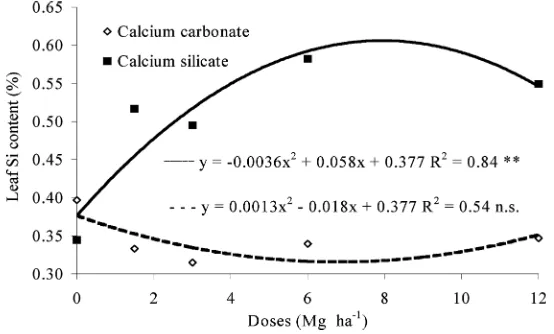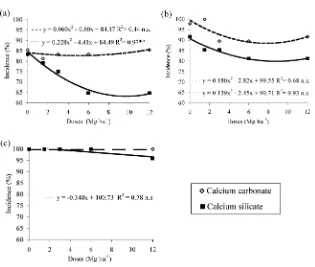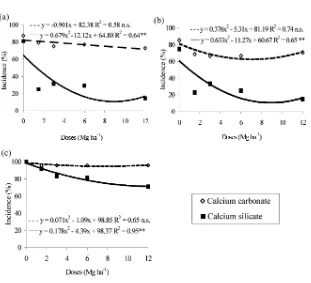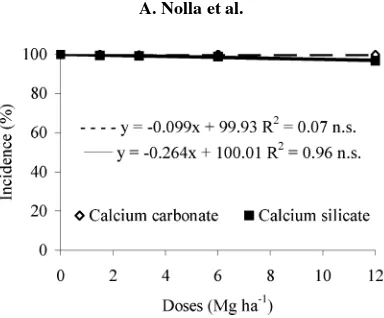ISSN: 0190-4167 print / 1532-4087 online DOI: 10.1080/01904160600932658
Efficiency of Calcium Silicate and Carbonate
in Soybean Disease Control
Antonio Nolla, Gaspar Henrique Kornd¨orfer, and L´ısias Coelho
Universidade Federal de Uberlˆandia, Instituto de Ciˆencias Agr´arias, Uberlˆandia (Minas Gerais), Brazil
ABSTRACT
Silicon (Si) affects the susceptibility of plants to fungal attack. In plants with low Si accumulation, disease-control mechanisms involve the accumulation of phenolic com-pounds and Si. This study compared the effects of calcium silicate and carbonate doses on the control of soybean (Glycine max) diseases. A sandy soil was collected from Santa Vit´oria, Minas Gerais state, Brazil, of which 200 kg was placed in plastic drums in a protected, uncovered area. Calcium carbonate or silicate was applied superficially in amounts equivalent to 0, 1500, 3000, 6000, or 12,000 kg ha−1, and soybean was
culti-vated for 120 d. Leaf Si concentration and incidence ofCercospora sojina(Frog’s eye spot),Peronospora manshurica(downy mildew), andPhakopsora pachyrhizi(Asian rust) were evaluated. Calcium carbonate did not reduce disease incidence; however, cal-cium silicate was effective in the reduction of downy mildew at 47 and 66 d after soybean seeding, and of frog’s eye spot incidence at all dates evaluated. Asian rust was observed only at 79 d after seeding and calcium silicate was not effective in its reduction.
Keywords: fertilization, silicon, phytoalexins, slag, resistance mechanism, defense to biotic stress
INTRODUCTION
Plant mineral nutrition is an environmental factor that can be managed with rel-ative ease, and is an important component in disease control (Marschner, 1995). In this aspect, several studies have shown that silicon (Si) is a factor affecting the
Received 31 January 2005; accepted 13 June 2006.
Address correspondence to Antonio Nolla, Universidade Federal de Uberlˆandia, In-stituto de Ciˆencias Agr´arias, Caixa Postal 593 Bairro: Umuarama CEP 38400-902, Uberlˆandia (Minas Gerais), Brazil. E-mail: nolla73@hotmail.com
susceptibility of cereals, such as rice (Oryza sativa) and several dicotyledons, to fungal attack (Jones and Handreck, 1967; Menzies and B´elanger, 1996).
Many independent studies have confirmed the importance of Si in resis-tance to abiotic [iron (Fe), manganese (Mn), and sodium (Na) toxicity] and biotic (insects and fungi) stresses. Silicon accumulation and deposition in the epidermal cells can be an effective mechanical barrier to fungal penetration. However, the mechanical barrier made by Si in the epidermal cells is not the only mechanism of prevention of fungal penetration or insect attack. Recent research results suggest that Si acts in the host tissue by altering the signals be-tween host and pathogen, resulting in a faster and more extensive activation of plant defense mechanisms, as shown for cucumber (Cucumis sativas) (Samuels et al., 1991; Ch´erif et al., 1994; Marschner, 1995).
Silicon can form complexes with phenolic compounds and increase their synthesis and mobility in the apoplasm (Menzies et al., 1991). A quick de-position of phenolic compounds or lignin in the infection courts is a defense mechanism against a fungal attack, and the presence of soluble Si facilitates this resistance mechanism (Menzies et al., 1991).
Plant resistance to diseases can be enhanced by the alteration of plant responses to a pathogen challenge, by increasing toxin synthesis (phytoalex-ins), which can act as inhibitory and repellent substances, or by promoting the formation of biochemical barriers (Marschner, 1995). Phytoalexins are small molecules produced in the plant after a microorganism infection or stress and play an important role in resistance to diseases and pests. Frequently, phytoalex-ins are also toxic to the host, killing the cells as it is accumulated. Resistance to a pathogen is observed when these compounds accumulate quickly and in high concentrations in the infection court, resulting in pathogen death (Fosket, 1994). Several flavonoids in legume (e.g. peas, soybean) root exudates can act as suppressors of certain pathogenic fungi, and are considered phytoalex-ins (Dixon, 1986; Hartwig, 1994). In plant-pathogen interactions, certain final products of flavonoid biosynthesis act as phytoalexins in plant defense reactions (Hahlbrock and Scheel, 1989; Peters and Verma, 1990).
Broad-leaf plants, such as soybean and cucumber, are characterized in relation to Si contents and proportions of Si/Calcium (Ca) as intermediate (1%– 3% dry weight), meaning that when the Si concentration in the environment is high, the plants contain a considerable amount of Si; there is evidence that these plants transport Si freely from the root system to their canopies (Miyake and Takahashi, 1995).
corrective and a Si source, increased soybean resistance to stem canker. Lesion length, caused by the fungus in the pith of diseased plants, was decreased up to 90%. This lesion decrease was linear with the addition of up to 40 mg L−1
Si to the nutrient medium (Grothge-Lima, 1998). However, no effect was ob-served on leaf application of Si. This lack of control could be attributed to Si immobility in the plant, hindering its movement to the infection court, or to its sole movement in the apoplast. Because soybean is an intermediate type plant, i.e., it absorbs and translocates appreciable amounts of Si when Si is available in large amounts in the substrate, providing Si through a nutrient solution could enhance plant resistance to diseases.
Disease management has been accomplished through resistant cultivars and the use of fungicides. Although these methods reduce disease problems, new pathogen races can break resistance within a few years after introduction of a cultivar. Also, fungicide use is considered a high-technology input, not always available for small farmers, in addition to besides being a source of pollution in the environment when due care is not taken in its handling and spraying. As a consequence, the use of more sustainable strategies for disease control is highly desirable. Mineral nutrition as a means to increase plant resistance is sustainable and contributes to soil conservation and to the maintenance of human health. Silicon fertilization may provide an alternative that avoids these problems, as research from several countries has shown.
This study compared the effect of calcium carbonate and calcium silicate doses soybean disease control.
MATERIALS AND METHODS
Soil classified as Ustoxic Quartzipsamment (USA, 1998), was collected in Santa Vit´oria County, located in the state of Minas Gerais, Brazil, in a native forest formation; its chemical characterization is described in Table 1. Its soil was
Table 1
Chemical characteristics of the Ustoxic Quartzipsamment soil used in the experiment
pH (H2O) Ca Mg Al VP K H+Al VCEC B.S. m O.M. Si
1:2.5 cmolcdm−3 mg·dm−3 cmolcdm−3 % g kg−1 mg kg−1
4.6 0.1 0.1 0.7 1.3 19 4.5 4.77 5 74 17 0.6
Ca, Mg, Al=(extractor−KCl 1 N); P, K=(extractor−HCl 0.05 N+H2SO4
0.025 N); H+Al=potential acidity (extractor – calcium acetate); T=CTC pH 7; V
=base saturation; MO=(Walkley-Black); Si=(extractor – CaCl20.01 mol L−1).
selected due to its low concentration of available Si (sandy texture) (Beckwith and Reeve, 1963) and, consequently, greater probability of plant response to soil application of that element.
Due to the naturally low fertility of the soil collected, soil fertilization was performed by adding, with the aid of a concrete mixer, the equivalent of 400 kg P2O5ha−1, 400 kg K2O ha−1, 240 kg magnesium (Mg) ha−1, and 100 kg of a
micronutrient fertilizer in the form of frited trace element (FTE) [9% zinc (Zn), 1.8% boron (B), 2% manganese (Mn), 0.8% copper (Cu), 0.1% molybdenum (Mo), and 3% iron (Fe)]. Subsequently, 200 kg lots of the soil were placed in
250 L drums 54 cm in diameter×83 cm in height. The drums were placed
in an open and fenced area over crushed rocks to avoid contamination of the soil in the columns. Excess water in the columns was avoided by punching five 1.3 cm diameter holes into the upper and lower ends of the side of the drum.
The equivalent of 0, 1500, 3000 (liming requirement), 6000, and 12,000 kg ha−1calcium carbonate (99% CaCO
3) or calcium silicate, provided
by the company Rockfibras do Brasil (18% CaO and 40% SiO2), was applied
to the column surface (without incorporation), in a randomized block design with four repetitions, as a 2×5 factorial experiment (two materials and five doses). The soil columns were left fallow for 15 d, then irrigated with 12 L of water immediately after the application of the corrective materials to allow for a better reactivity with the soil.
The soybean cultivar used was BRS/MG-68 ‘Vencedora,’ which has a deter-minate growth habit; average plant height of 80 cm; average insertion height of the first pod of 15 cm; purple-colored flowers; brown pubescence; black hilum; good resistance to stalking; good seed quality and resistance to frog’s eye spot (Cercospora sojina), bacterial pustule (Xanthomonas campestrispvglycinea), bacterial blight (Pseudomonas syringaepv glycinea), powdery mildew ( Mi-crosphaera diffusa), and stem canker (Phomopsis phaseolif.sp.meridionalis). This cultivar is also tolerant to the gall nematodes (Meloydogine incognita
andM. javanica); however, it is susceptible to the cyst nematode (Heterodera glycines) (EMBRAPA, 2004).
TwentyBradyrhizobium japonicumpre-inoculated seeds were planted on December 23, 2003 in the drums, in two rows spaced at 0.25 cm, and were thinned to five plants per row. Soybean seeds were not fungicide treated, so dis-ease development could be monitored during the culture cycle. The experiment simulated direct planting and culture rotation with sugar cane (Saccharum of-ficinarum); therefore, the equivalent of 10 mg ha−1sugar cane straw mulch was
applied to the surface of the drums. The soil moisture was maintained through rainfall or by irrigation (with tap water) during the dry season.
Only an insecticide was used for pest (Nezara viridula) control during the culture cycle. Evaluation for disease (Peronospora manshurica—Downy
mildew, Cercospora sojina—frog’s eye spot, andPhakopsora pachyrhizi—
scale (Kranz, 1990), assessing disease incidence by visual evaluation as a per-centage of leaves affected per plant by each pathogen.
Soybean leaves were collected for nutrient analysis at the flowering stage (R1) (Ritchie et al., 1982) by picking 30 fully expanded leaves without their
pedicels (third leaf from the top meristem of the stem). Leaf Si content was determined using the yellow method (Elliot and Snyder, 1991).
Harvest was performed 120 d after seeding; however, Phakopsora
pachyrhizi(Asian rust) severity compromised plant development and pod pro-ductivity in the experiment, which had to be terminated earlier than planned. Therefore, the soybean canopy was cut and maintained as mulch for a subse-quent experiment.
All of the data were submitted to analysis of variance, using the statistics program SANEST (Machado and Zonta, 1991) and the averages compared by the Tukey test at 5% probability.
RESULTS AND DISCUSSION
Tissue Si content in soybean demonstrated that, in general, soybean cultivated on calcium carbonate-treated soil accumulated little Si in the leaves (Figure 1), as was expected, because calcium carbonate does not have Si in its composition; the sandy soil had little available Si; and soybean is an intermediate accumulating plant for Si. According to Marschner (1995), soybean accumulates less than 0.23% Si in its tissues. However, under the silicate treatments, greater leaf Si content was observed, than under the carbonate treatments. Application of
calcium silicate increased leaf Si concentration up to 1.70 fold, varying from 0.34% to 0.55% if silicate was applied at doses of 0 or 12 mg ha−1(Figure 1).
These values were higher than those reported by Grothge-Lima et al. (1998) (0.02%–0.45%) after the application of 0 or 100 mg Si kg−1(Si metasilicate—
Na2SiO3·5H2O) in nutrient solution. These differences could be explained by
the sampling method adopted in each study. Here, the third leaf pair at flowering stage (stage R1), was sampled, whereas Grothge-Lima et al. (1998), sampled
stem and leaves at stage V1. Therefore, a longer growth period was allowed, and
the plant tissues analyzed could explain the different Si contents between the two studies. Also, the increase in Si content under the treatments where silicate was applied was significant because the soil (Ustoxic Quartzipsamment) studied had low natural availability of Si (0.6 mg dm−3
).
The increase in leaf Si concentration in soybean under the treatments where silicate was applied is desirable, as supplying silicate has been shown to con-tribute to reduction ofFusarium solani(soybean sudden-death syndrome) and stem canker in soybean plants (Juliatti et al., 2003). In cucumber, Si acts in the host tissue, affecting signaling between host and pathogen, which results in a faster and more extensive activation of plant defense mechanisms, probably as a function of phytoalexin production (Samuels et al., 1991; Ch´erif et al., 1994). The observation of downy mildew incidence on soybean leaves at 47, 66, or 79 d after seeding indicated that the disease was not controlled in the calcium carbonate plots (Figure 2). However, there was a reduction of downy mildew in-cidence under the silicate treatments, especially at 47 d after seeding (Figure 2a), from 85% (no silicate) to 65% (12 mg ha−1
calcium silicate), demonstrating the efficacy of Si in disease control in the first evaluation. This reduction probably occurred as a function of greater Si accumulation in soybean leaf tissue under the silicate treatments (Figure 1). It is expected that, in cropping areas, this reduction in disease incidence after soil incorporation of calcium silicate could also result in a reduction in use of fungicide sprays, as well as lead to a greater yield due to the longer maintenance of photosynthesizing area.
Figure 2. Leaf incidence (%) of downy mildew (Peronospora manshurica) in soybean cultivar BRS/MG-68 ‘Vencedora’ at (a) 47, (b) 66, and (c) 79 d after seeding, as a function of the application of increasing doses of calcium carbonate or silicate.
Frog’s eye spot was another disease observed during the culture cycle. Although the cultivar BRS/MG-68 ‘Vencedora’ is resistant to this disease (EMBRAPA, 2004), the disease was observed in the experiment, probably due to favorable environmental conditions. In general, comparing leaf disease inci-dence, at 47, 66, and 79 d after seeding, it was noted that calcium carbonate did not control the disease (Figure 3). However, under the silicate treatments, there was a significant reduction of frog’s eye spot incidence at 47 d (Figure 3a), from 81% (no silicate) to 14% (12 mg ha−1 calcium silicate), emphasizing
Figure 3. Leaf incidence (%) of frog’s eye spot (Cercospora sojina) in soybean cultivar BRS/MG-68 ‘Vencedora’ at (a) 47, (b) 66, and (c) 79 d after seeding, as a function of the application of increasing doses of calcium carbonate or silicate.
signaling, hampering fungal metabolism, and quickly activated plant defense mechanisms, as has been observed in cucumbers (Samuels et al., 1991; Ch´erif et al., 1994; Marschner, 1995; Kornd¨orfer et al., 2004). Therefore, it is impor-tant to highlight that the presence of Si in leaf tissue can be fundamental to increasing plant resistance to diseases as a function of toxin synthesis (phy-toalexins), which can act as inhibitory or repellent substances for pathogens and pests (Marschner, 1995; Grothge-Lima, 1998; Kornd¨orfer et al., 2003).
Calcium carbonate was not effective for the control of frog’s eye spot at 66 d after seeding (Figure 3b), as expected. Greater resistance to frog’s eye spot was still observed under the silicate treatments, which maintained the same control level as at 47 d (Figure 3a), varying from 75% (no silicate) to 14% (12 mg ha−1
different sources of silicate. Therefore, a reduction in the number of sprays for control of frog’s eye spot can be expected following incorporation of silicate to the soil. Juliatti et al. (2004a) also observed a reduction of up to 50% in sudden-death syndrome and stem canker on soybean after silicate incorporation into the soil. Santos (2002) and Pozza and Pozza (2003) also noted the efficacy of silicate on the control of coffee frog’s eye spot (Cercospora coffeicola). The resistance mechanism of host resistance to the pathogen was probably a biochemical barrier (B´elanger, 2003) or the production of phenol chitinases and peroxidases (Ch´erif et al., 1994; Fawe, et al., 1998; Epstein, 1999).
Frog’s eye spot incidence increased later in the season, as observed for downy mildew (Figure 3c). There was no disease control under the calcium carbonate treatments, and the number of diseased plants was greater than 96%; however, under the silicate treatments, disease incidence varied from 100% (no silicate) to 71% (12 mg ha−1 calcium silicate). This effect probably occurred
because no disease control measures were employed, and conducting the test in an open area favored fungal proliferation. Moreover, it is important to note that 79 d after seeding, soybean was already flowering (R1), and between flowering
and grain filling, water and nutrient requirements are at their maximum (Costa, 1996); thus, the high nutrient requirement at this stage could reduce soybean natural resistance to diseases such as downy mildew (Figure 2c) and frog’s eye spot (Figure 3c). According to observations by Kornd¨orfer et al. (2004), soil incorporation of Si sources does not eliminate disease incidence. However, as observed by Juliatti et al. (2004b), results of disease incidence on soybean could indicate that field incorporation of silicate has been important in a reduction of the number of fungicide sprays early in the growing season, increasing the grower’s savings.
Figure 4. Leaf incidence (%) of Asian rust (Phakopsora pachyrhizi) on soybean cul-tivar BRS/MG-68, ‘Vencedora’ 79 d after seeding, as a function of the application of increasing doses of calcium carbonate or silicate.
It is possible that the increase in frog’s eye spot (Figure 2) and downy mildew (Figure 3) incidence at 79 d after seeding could be due to the occurrence of Asian rust in the soybeans (Figure 4), thus favoring the development of diseases in all treatments. This increase in disease incidence, in turn, could mean that Si use would be effective for the control of diseases that are not as aggressive, such as frog’s eye spot and downy mildew.
CONCLUSIONS
A pre-seeding soil application of silicate increased leaf-tissue silicate concen-tration. This greater leaf concentration was effective on reducing downy mildew incidence at 47 or 66 d after seeding, and frog’s eye spot at all evaluations; how-ever, no control of Asian rust was observed. In contrast, calcium carbonate did not reduce frog’s eye spot, downy mildew, or Asian rust incidence.
ACKNOWLEDGMENTS
The authors acknowledge the Brazilian National Research Council (CNPq) for financial support and fellowships.
REFERENCES
B´elanger, R. R., N. Behamou, and J. G. Menzies. 2003. Cytological evidence of an active role of silicon on wheat resistance to powdery mildew (Blumeria graminisf.sp.tritici).Phytopathology23: 402–412.
Ch´erif, M., A. Asselin, and R. R. B´elanger. 1994. Defense responses induced by soluble silicon in cucumber roots infected byPythiumspp.Phytopathology
84: 236–242.
Costa, J. A. 1996.Soybean culture (Cultura da soja). Porto Alegre, Brazil: Evangraf.
Dixon, R. A. 1986. The phytoalexin response: Elicitation, signaling and control of host gene expression.Biological Reviews of the Cambridge Philosoph-ical Society61: 239–291.
Elliott, C. L., and G. H. Snyder. 1991. Autoclave-induced digestion for the colorimetric determination of silicon in rice straw.Journal of Agricultural and Food Chemistry39: 118–1119.
EMBRAPA. 2004.Technical recommendations for soybean in central Brazil,
2003/2004(in Portuguese) Londrina, Brazil: Embrapa Soja.
Epstein, E. 1999. Silicon. Annual Review of Plant Physiology 50: 729–
732.
Fawe, A., M. Abou-Zaid, J. G. Menzies, and R. R. B´elanger. 1998.
Silicon-mediated accumulation on flavonoid phytoalexins in cucumber.
Phy-topathology88: 396–401.
Fosket, D. E. 1994.Plant growth and development: A molecular approach. San Diego, CA: Academic Press.
Grothge-Lima, M. T. 1998. Inter-relation of stem canker (Diaporthe phase-olorumf. sp.meridionalis), nodulation (Bradyrhizobium japonicum) and
silicon in soybean [Glycine max (L.) Merrill] (in Portuguese), PhD
diss., Centro de Energia Nuclear na Agricultura, Universidade de S˜ao Paulo.
Gupta, G. K. 2004. Major soybean diseases in India: Economic impact and control strategies adopted. Paper presented at the VII World Soybean Re-search Conference, IV International Soybean Processing and Utilization Conference, and III Brazilian Soybean Congress, Foz do Iguassu, Brazil, 624–630.
Hahlbrock, K., and D. Scheel. 1989. Physiology and molecular biology of phenylpropanoid metabolism.Annual Review of Plant Physiology40: 347– 369.
Hartwig, E. E. 1994. Registration of near isogenic soybean germplasm lines D68-0099 and D68-0102, differing in ability to form nodules.Crop Science
34: 822.
Jones, L.H.P., and K.A. Handreck. 1967. Silica in soils, plants, and animals.
Advances in Agronomy19: 107–149.
Juliatti, F. C., E. N. Borges, R. R. L. Passos, J. C. Caldeira Jr., F. C. Juliatti, and A.
M. Brand˜ao. 2003. Soybean diseases (in Portuguese)Cultivar—Grandes
Juliatti, F. C., M. G. Pedrosa, R. M. Q. Lanna, C. H. Brito, and B. Mello 2004b. Influence of silicon on the reduction of seedling damping off (Fusarium semitectum) in soybean (in Portuguese).Bioscience Journal20: 57–63. Juliatti, F. C., A. C. Polizel, and F.C. Juliatti. 2004a.Integrated disease
manage-ment in soybeans(in Portuguese) Uberlˆandia, Brazil: Composer Gr´afica e Editora.
Juliatti, F. C., F. A. Rodrigues, G. H. Kornd¨orfer, O. A. Silva, and J. R. Peixoto. 1996. Effect of silicon in resistance induction againstDiaporthe phaseolo-rumf.sp.meridionalisin soybean cultivars with different resistance levels (Efeito do sil´ıcio na indu¸c˜ao de resistˆencia aDiaporthe phaseolorumf.sp.
meridionalisem cultivares de soja com diferentes n´ıveis de resistˆencia).
Fitopatologia Brasileira21(supplement): 26.
Kornd¨orfer, G. H., H. S. Pereira, and M. S. Camargo. 2004.Calcium and mag-nesium silicates in agriculture(in Portuguese), 3rd edition. Uberlˆandia, Brazil: GPSi/ICIAG/UFU.
Kranz, J. 1990. Monitoring epidemics: disease. InIntroduction to plant disease, eds. C.L. Campbell and L. V. Madden, 107–128. New York: John Wiley. Machado, A. A., and E. P. Zonta. 1991.User’s Guide for Sanest:A system for
statiscal analyses in microcomputers(in Portuguese) Rio Grande do Sul, Brazil: UFPel.
Marschner, H. 1995.Mineral nutrition of higher plants. 2nd edition; New York: Academic Press.
Menzies, J. G., and R. R. B´elanger. 1996. Recent advances in cultural manage-ment of diseases of greenhouse crops.Canadian Journal of Plant Pathology
18: 186–193.
Menzies, J. G., D. L. Ehret, A. D. M. Glass, and A. L. Samuels. 1991. The influ-ence of silicon on cytological interactions betweenSphaerotheca fuliginea
andCucumis sativus. Physiological and Molecular Plant Pathology39: 403–414.
Miyake, Y., and E. Takahashi. 1995. Effect of silicon on the growth of soybean plants in a solution culture.Soil Science and Plant Nutrition 31: 625– 636.
Morgan-Jones, G. 1989.The Diaporthe/Phomopsis complex: Taxonomic
con-siderations. Paper presented at the IV World Soybean Research Confer-ence, Buenos Aires, Argentina, 1699–1706.
Oliveira, A. C. B. 2004. Soybean rust: Season 2002/2003 in Bahia. Paper pre-sented at the VII World Soybean Research Conference, IV International Soybean Processing and Utilization Conference, and III Brazilian Soybean Congress, Foz do Iguassu, Brazil, 1308–1312.
Peters, N. K., and D. P. S. Verma. 1990. Phenolic compounds as regulators of gene expression in plant-microbe interaction.Molecular Plant Microbe Interactions3: 4–8.
Ritchie, S., J. J. Hanway, and H. E. Thompson. 1982.How a soybean plant develops, (Special Report, 53). Ames, IA: Iowa State University of Science and Technology.
Samuels, L., A. D. M. Glass, D. L. Ebret, and J. G. Menzies. 1991. Mobility and deposition of silicon in cucumber-plants.Plant Cell and Environment
14: 485–492.
Santos, D. M. 2002. Effect of silicon on frog’s eye spot (Cercospora coffeicola
Berk & Cooke) on coffee (Coffea arabicaL.) seedlings (in Portuguese), master’s thesis, Universidade Federal de Lavras.
United States Department of Agriculture, Natural Resources Conservation Ser-vice, Soil Survey Staff. (USA) 1998.Keys to soil taxonomy. 8th edition Washington, DC: Department of Agriculture.



